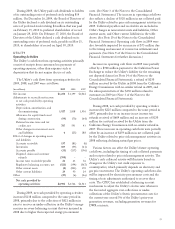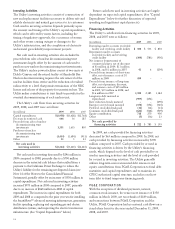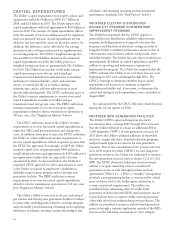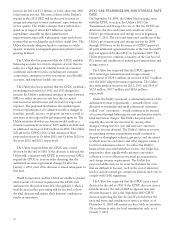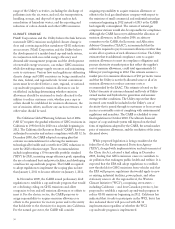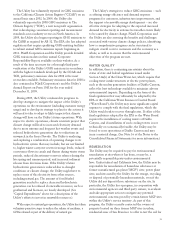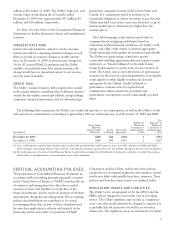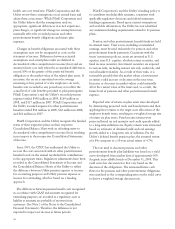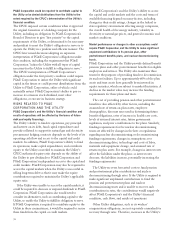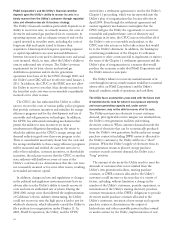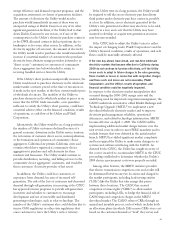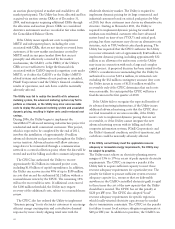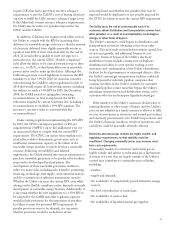PG&E 2009 Annual Report Download - page 37
Download and view the complete annual report
Please find page 37 of the 2009 PG&E annual report below. You can navigate through the pages in the report by either clicking on the pages listed below, or by using the keyword search tool below to find specific information within the annual report.
million at December 31, 2009. The Utility’s high, low, and
average values-at-risk during the 12 months ended
December 31, 2009 were approximately $17 million, $9
million, and $14 million, respectively.
See Note 10 of the Notes to the Consolidated Financial
Statements for further discussion of price risk management
activities.
INTEREST RATE RISK
Interest rate risk sensitivity analysis is used to measure
interest rate risk by computing estimated changes in cash
flows as a result of assumed changes in market interest
rates. At December 31, 2009, if interest rates changed by
1% for all current PG&E Corporation and the Utility
variable rate and short-term debt and investments, the
change would have an immaterial impact to net income
over the next 12 months.
CREDIT RISK
The Utility conducts business with counterparties mainly
in the energy industry, including other California investor-
owned electric utilities, municipal utilities, energy trading
companies, financial institutions, and oil and natural gas
production companies located in the United States and
Canada. If a counterparty failed to perform on its
contractual obligation to deliver electricity or gas, then the
Utility may find it necessary to procure electricity or gas at
current market prices, which may be higher than the
contract prices.
The Utility manages credit risk associated with its
counterparties by assigning credit limits based on
evaluations of their financial conditions, net worth, credit
ratings, and other credit criteria as deemed appropriate.
Credit limits and credit quality are monitored periodically.
The Utility ties many energy contracts to master
commodity enabling agreements that may require security
(referred to as “Credit Collateral” in the table below).
Credit Collateral may be in the form of cash or letters of
credit. The Utility may accept other forms of performance
assurance in the form of corporate guarantees of acceptable
credit quality or other eligible securities (as deemed
appropriate by the Utility). Credit Collateral or
performance assurance may be required from
counterparties when current net receivables and
replacement cost exposure exceed contractually specified
limits.
The following table summarizes the Utility’s net credit risk exposure to its counterparties, as well as the Utility’s credit
risk exposure to counterparties accounting for greater than 10% net credit exposure, as of December 31, 2009 and 2008:
(in millions)
Gross Credit
Exposure
Before Credit
Collateral(1)
Credit
Collateral Net Credit
Exposure(2)
Number of
Wholesale
Customers or
Counterparties
>10%
Net
Exposure to
Wholesale
Customers or
Counterparties
>10%
December 31, 2009 $202 $24 $178 3 $154
December 31, 2008 $240 $84 $156 2 $107
(1) Gross credit exposure equals mark-to-market value on physically and financially settled contracts, notes receivable, and net receivables (payables)
where netting is contractually allowed. Gross and net credit exposure amounts reported above do not include adjustments for time value or liquidity.
(2) Net credit exposure is the Gross Credit Exposure Before Credit Collateral minus Credit Collateral (cash deposits and letters of credit). For purposes
of this table, parental guarantees are not included as part of the calculation.
CRITICAL ACCOUNTING POLICIES
The preparation of Consolidated Financial Statements in
accordance with accounting principles generally accepted
in the United States of America (“GAAP”) involves the use
of estimates and assumptions that affect the recorded
amounts of assets and liabilities as of the date of the
financial statements and the reported amounts of revenues
and expenses during the reporting period. The accounting
policies described below are considered to be critical
accounting policies due, in part, to their complexity and
because their application is relevant and material to the
financial position and results of operations of PG&E
Corporation and the Utility, and because these policies
require the use of material judgments and estimates. Actual
results may differ substantially from these estimates. These
policies and their key characteristics are outlined below.
REGULATORY ASSETS AND LIABILITIES
The Utility’s rates are primarily set by the CPUC and the
FERC and are designed to recover the cost of providing
service. The Utility capitalizes and records, as a regulatory
asset, costs that would otherwise be charged to expense if it
is probable that the incurred costs will be recovered in
future rates. The regulatory assets are amortized over future
33


